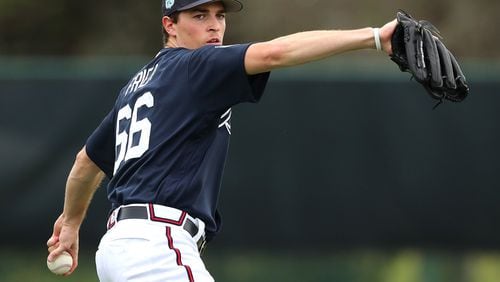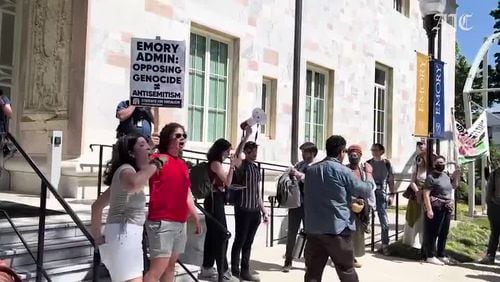Patrick Weigel was a 6-foot-6, hard-throwing high school senior in Ventura, Calif., in 2012, when a pair of prep pitchers, Max Fried and Lucas Giolito, from down the coast in Los Angeles were the top dogs.
“Even when I was a senior in high school, him and Giolito — they were about 40 minutes from my high school — I didn’t play against them or anything, but growing up in my area all we heard about was Giolito and Max Fried,” Weigel said of the pair of 2012 first-round draft picks out of Harvard-Westlake High School. “Those were the two guys in southern California that were the dudes.”
Four years later, Weigel and Fried were teammates at low Single-A Rome and members of a starting rotation that might go down as one of the greatest in minor league history. For Fried, it marked a return from a 21-month rehabilitation for Tommy John surgery, most of that rehab coming after he was traded from the Padres while his scar was still fresh.
Weigel was named the Braves’ 2016 organizational pitcher of the year, but to hear him tell it, by the end of the season Fried had reclaimed dude status and was the team’s dominant pitcher. This winter, the lefty Fried regained his status as a top-50 prospect, his career now back in ascend mode.
He features a 94-96 mph fastball, two versions of a plus-curveball, and a change-up. Fried also features something else honed through difficult times over the past couple of years.
“What impressed me about Max was his resiliency,” Weigel said. “I know it was a tough recovery for him, sitting out those two years. I can’t imagine sitting out two years. But his resiliency. … He kind of struggled early in the season, but he kept the same attitude, kept coming at it, and at the end of the year everyone saw he was a dude.
“He was utterly dominant at the end of the year. There’s no other way to put it.”
Indeed, in Fried’s final four starts — two regular-season starts, two postseason — he had 44 strikeouts and seven walks in 25 1/3 innings. That flourish probably assured a bump to high-A or perhaps Double-A to start the 2017 season, and some believe Fried might even reach the majors at some point in 2017.
He was only 8-7 with a 3.93 ERA and 112 strikeouts in 103 innings of 21 regular-season games including 20 starts in 2016, but in his last 11 starts he fashioned a 2.80 ERA with 72 strikeouts and 19 walks in 54 2/3 innings. As if those stats weren’t impressive enough, consider how he got to that point.
Fried was Baseball America’s No. 53 prospect before damaging the ulnar collateral ligament in his left elbow and having Tommy John surgery in August 2014. He was traded to the Braves four months later as the best of four prospects in a deal that sent Justin Upton to San Diego.
“(The trade) was definitely tough,” said Fried, a slender 6-feet-4 and 200 pounds. “I was surprised by it. Couple of months out of surgery, I haven’t even touched a baseball yet and I get a phone call saying I’ve been traded. Definitely a surprise, but one that I couldn’t be happier with because ever since I’ve been (in the Braves organization) I’ve been welcomed with open arms.
“I feel like I was pretty much drafted here, with the way that I’ve been treated. I can’t thank the Braves enough for the way they’ve handled my situation. It’s been unbelievable.”
He was held out the entire 2015 season by the Braves, whose current front office errs on the side of caution with prospects coming off surgeries. They now add months to typical rehab periods, after the Braves of the past had pitchers Kris Medlen, Brandon Beachy and Jonny Venters get re-injured following Tommy John surgery and 12-14 month rehabs.
“It was a long time,” Fried said. “The two-year rehab process and on top of that, just my little scuffles at the beginning (of the season), trying to find myself again after so much time off. It’s definitely been a journey, but it’s something I wouldn’t trade because I’ve learned so much about myself and what I need to do in times of either adversity or just trying to find yourself again.”
Fried had a 5.85 ERA in his first seven starts in 2016, with 28 strikeouts and 16 walks in 32 1/3 innings through May 14. He worked five innings or fewer in six of those games, twice needing more than 80 pitches to get through five.
Then he posted a 1.98 ERA in his next 10 starts, with 56 strikeouts and 23 walks in 50 innings. Fried held opponents to a .203 average and .561 OPS in that span before leaving the last start after two innings July 15 because of a recurring finger blister, which forced him to the seven-day DL for the second time in 10 days. He didn’t pitch again until Aug. 14.
During the down time, Fried remained positive in part because of Rome pitching coach Dan Meyer, who’s developed a bond with Fried. Meyer, a 35-year-old former major league lefty and Braves first-round draft pick in 2002, last pitched in the majors in 2010 and was hired for a newly created position as Braves pitching-rehab coordinator in March 2015.
He moved into the Rome pitching coach position before the 2016 season.
“I’ve been fortunate because ever since I’ve been here I’ve worked with the same pitching coach, Dan Meyer,” Fried said. “So I’ve had a really good relationship with him and I can always go to him if I need something pitching-wise. Beyond that I’m really comfortable with him, he’s someone that really helped me kind of get through those struggles last year.
“He was the one at the beginning of the year that said, ‘You’re going to struggle the first half. Then watch, the second half you’re going to start to feel like yourself again and things will come together.’ It was really nice to actually have what he said come to fruition.”
Meyer said Fried is a laid-back Californian off the field, but a different guy on the mound. Tough and aggressive.
“You’d see (his big potential) in spurts here and there,” Meyer said. “To be honest you, I expected it for a kid who hasn’t pitched in two years competitively. Chuck Hernandez, our (minor league) pitching coordinator at the time — now our (major league) pitching coach — would say, ‘His timing’s just a little off, once it comes together you’ll be able to see it.’
“You’d see it and say, he’s close, he’s close. I think he came back from his blister and he maybe had a bad start, and a lot of kids at that level might have just kind of caved. He went the other way and just got better and better.
Fried lost two of his first three starts back from that second DL stint and gave up 15 hits and 11 earned runs in 16 innings in those three outings. But he began to ramp up his strikeout totals, posting a season-high 10 strikeouts with two walks in six innings Aug. 28 and striking out 10 with only one walk in 4 2/3 innings Sept. 3 in his final regular-season start.
That gave him a 2.80 ERA in his last 11 regular-season starts, with only two homers allowed, a .220 opponents’ average and .641 opponents’ OPS allowed in that span.
Then he took his game to another level in the postseason, going 2-0 with a 1.23 ERA in two starts with 24 strikeouts and four walks in 14 2/3 innings. He allowed two runs and had a .135 opponents’ average and 0.75 WHIP in the postseason.
He was back. A dude.
About the Author






